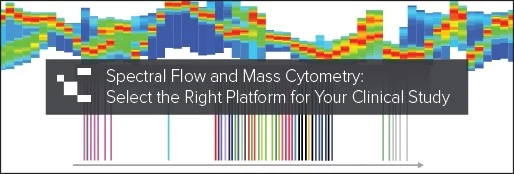July 2, 2024

Choosing the right cytometry platform is crucial for optimizing your clinical study. Both mass cytometry (CyTOF) and spectral flow cytometry are widely used technologies for clinical single-cell analysis.
These platforms provide the ability to build panels of a size that go beyond conventional flow cytometry, allowing a stronger multi-parametric approach to data generation. However, selecting the appropriate technology is key to unlocking the complexities of clinical development.
This blog post compares the two platforms to help you make an informed decision for your clinical immune monitoring.
Sample matrix considerations for both spectral flow and mass cytometry
Both mass and spectral flow cytometry platforms can handle various sample types, including peripheral blood mononuclear cells (PBMCs), fresh whole blood, gently fixed samples, or frozen specimens that have undergone an initial fixation step.
When analyzing fixed frozen samples, it is important to fix the specimen soon after drawing the blood; ideally within two hours. Due to the unstable nature of granulocytes, they tend to degranulate and clump up if the specimen is not fixed and frozen in a timely manner.
Another important consideration is the amount of time the specimen is exposed to fixative prior to freezing. Over fixing the cells can lead to deleterious epitope alteration and incomplete hemolysis upon thawing. Failure to take these points into consideration could compromise data quality.
For PBMCs or fresh whole blood, the performance of both technologies is comparable. For these matrices, quality of samples, careful clone selection and fluorophores or heavy metal combination are the crucial elements to consider.
The choice between mass and spectral flow cytometry may also depend on the availability of cells.
Mass cytometry typically requires a higher cell input for samples (2-3 fold higher), which becomes crucial when working with low-yield samples like tumour-infiltrating lymphocytes (TILs) or cells taken from biopsies, as approximately 15-25% of cells are lost during acquisition.
In scenarios with limited cell availability, spectral flow cytometry is the preferred option to maximise the number of events analysed and generate quality data.
Markers, colours, and panel complexity are central to your platform choice
Both mass and spectral flow cytometry platforms can handle large panels of around 40 markers, but the intended use of the data should be considered when deciding on the panel size and complexity and may not be advisable for clinical settings.
Although most people associate spectral flow cytometry with large panels, it should also be considered that spectral flow cytometers, such as CYTEK Aurora, can excel with smaller panels (12 to 20 colours), especially for tracking lowly expressed markers, thanks to its ability to reduce overlap between fluorophores and autofluorescence.
Large panel sizes are made possible in mass cytometry given the platform has very minimal channel crosstalk as it is detecting highly purified isotopes of various heavy metals rather than a broad fluorescent spectrum.
It is important to carefully consider the intended use of the assay when deciding the size of the panel. For panels measuring target expression, receptor occupancy or providing absolute counts (through a lyse/no wash protocol) to support clinical decisions, creating a focused flow cytometry panel with fewer than 12 markers can provide more reliable results.
In these cases, a conventional flow cytometry instrument with easy standardization and built-in audit trails, such as the Lyric can be the better option.
It should also be noted that when your desired readout is the mean fluorescence intensity (MFI), conventional flow cytometry offers a more stable measurement across different runs than spectral flow cytometry.
Throughput for spectral flow and mass cytometry: acquisition rates, stability, and flexibility
Mass cytometry has slower acquisition rates compared to flow cytometry but has exceptionally long post-stain stability due to the stable nature of the reagents and the absence of autofluorescence which tends to gradually increase over time.
Conventional and spectral flow cytometry offer a higher comparable throughput but have more limited post-staining stability, typically lasting under 24 hours, which can be a drawback in certain scenarios.
Reflecting on spectral flow and mass cytometry reagents
With flow cytometry comes a wide selection of reagents, including a variety of clones and fluorochrome assignments offering more flexibility for panel design. In addition, customization of fluorochrome binding can be performed both through commercial sources or in-house, which is beneficial when specific fluorochromes are not commercially available or when using custom reagents from sponsors.
Mass cytometry has less commercially available reagents due to the sourcing of reagents being offered by only one company. Because of this limitation, custom conjugation with desired heavy metals is necessary for most panels. As a results, having the ability to perform custom conjugation in-house is a must to allow flexible panel design.
Both cytometry platforms can effectively integrate sponsors’ reagents, such as CAR detection reagents, ensuring seamless panel integration and compatibility with chosen platforms.
Mass cytometry or flow cytometry? It depends on your clinical objective
Both mass and spectral flow cytometry are valuable technologies for clinical immune monitoring. Selecting the most suitable platform requires a solid understanding of the relevant considerations as the choice of platform will most often come down to what markers are included in the panel of choice.
Our analytical team has unparalleled expertise in cytometry and leverages various techniques to yield the most informative results and quality data.
You can take a quick look at the table below-
| Key points to consider | Spectral Flow Cytometry | Mass Cytometry (CyTOF) |
|---|---|---|
| Cell Input Requirements | Lower cell input required, suitable for low-yield samples | Requires higher cell input, 2-3 times more than spectral flow cytometry |
| Panel Size and Complexity | Can handle large panels (40+ markers), but smaller panels (12-20 colors) can show better resolution of lowly expressed markers compared to conventional flow cytometry. | Large panels possible (40+ markers), minimal channel crosstalk due to heavy metal detection |
| Throughput and Acquisition | Higher acquisition throughput (comparable to conventional flow cytometry) but limited post-stain stability (<24 hours) | Slower acquisition rates but high post-stain stability due to the more stable nature of heavy metals compared to fluorochromes |
| Reagent Availability and Customization | Wide selection of fluorochrome-bound antibodies, allows for diverse marker choices and customization | Limited commercially available reagents, often require custom conjugation and offers limited clone selection |
Contact us to get your cytometry analysis project started!
About the author:

Damien Montamat-Sicotte is a Scientific Business Director at CellCarta, specializing in the flow Cytometry platform. With a PhD in immunology and post-doctoral expertise from various institutions, Damien has profuse experience in managing the processing and analysis of clinical samples by flow cytometry in an immune monitoring context.
You might also be interested by
CellTalk Blog
B-Cell Populations in Focus: A New Flow Cytometry Assay for Increased Sensitivity in Autoimmune Research
September 19, 2025
Flow Cytometry
More infoCellTalk Blog
Flow Cytometry Applications: Advanced Uses, Benefits, and Limitations
October 17, 2024
Flow Cytometry
More infoCellTalk Blog
How to ensure consistent flow cytometry readouts between labs and optimize your clinical trials
September 18, 2024
Flow Cytometry
More info